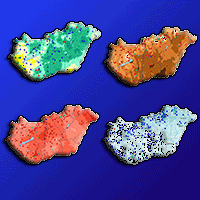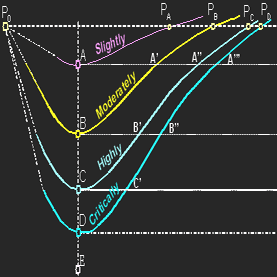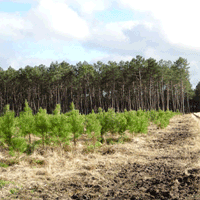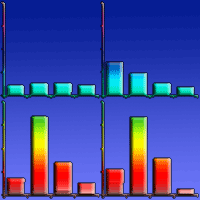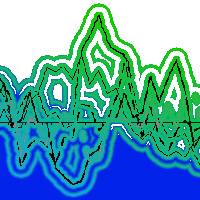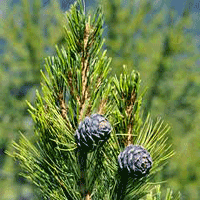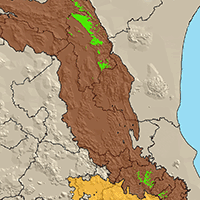
An assessment of climate change impacts on the tropical forests of Central America using the Holdridge Life Zone (HLZ) land classification system
K Khatun (1) , P Imbach (2), J Zamora (2)
iForest - Biogeosciences and Forestry, Volume 6, Issue 4, Pages 183-189 (2013)
doi: https://doi.org/10.3832/ifor0743-006
Published: May 08, 2013 - Copyright © 2013 SISEF
Research Articles
Abstract
Ecological models have predicted shifts in forest biomes, yet there have been very few studies that have looked at the implications on carbon stocks due to these shifts. Carbon is closely correlated to biomass and constitutes an important characteristic of the forest ecosystem. It has implications for conservation and land use practices, especially for climate change mitigation strategies currently under discussion, such as REDD+. This study couples the Holdridge Life Zone (HLZ) classification with the ECHAM5 model, to evaluate the impacts of climate change using the Special Report on Emissions Scenarios (SRES) A2, A1B and B1 for the Central American region. We utilize methodologies which combine biophysical variables with model output to assess the impacts on carbon stocks for two time periods, 2000 and 2100, . Results show that overall, the tropical category of the HLZ classification gains area as a result of one type of HLZ shifting to another forest type. In many cases the shifts result in some categories of HLZ being lost in their entirety. Elevation-associated life zones are particularly vulnerable to future climatic changes. A strong point of our approach is that differences between disaggregate regional and aggregate country levels can be compared. We suggest that a critical focus of conservation and management efforts should be concentrated on where vulnerable biomes are at most risk (biomes that shift and/or reduce fall under the vulnerable category).
Keywords
Authors’ Info
Authors’ address
Institute of Environmental Science and Technology (ICTA), Universitat Autònoma de Barcelona, 08193 Bellaterra (Spain)
Corresponding author
Paper Info
Citation
Khatun K, Imbach P, Zamora J (2013). An assessment of climate change impacts on the tropical forests of Central America using the Holdridge Life Zone (HLZ) land classification system. iForest 6: 183-189. - doi: 10.3832/ifor0743-006
Academic Editor
Roberto Tognetti
Paper history
Received: Aug 21, 2012
Accepted: Mar 01, 2013
First online: May 08, 2013
Publication Date: Aug 01, 2013
Publication Time: 2.27 months
Copyright Information
© SISEF - The Italian Society of Silviculture and Forest Ecology 2013
Open Access
This article is distributed under the terms of the Creative Commons Attribution-Non Commercial 4.0 International (https://creativecommons.org/licenses/by-nc/4.0/), which permits unrestricted use, distribution, and reproduction in any medium, provided you give appropriate credit to the original author(s) and the source, provide a link to the Creative Commons license, and indicate if changes were made.
Web Metrics
Breakdown by View Type
Article Usage
Total Article Views: 67458
(from publication date up to now)
Breakdown by View Type
HTML Page Views: 56720
Abstract Page Views: 4167
PDF Downloads: 4934
Citation/Reference Downloads: 38
XML Downloads: 1599
Web Metrics
Days since publication: 4601
Overall contacts: 67458
Avg. contacts per week: 102.63
Citation Metrics
Article Citations
Article citations are based on data periodically collected from the Clarivate Web of Science web site
(last update: Mar 2025)
Total number of cites (since 2013): 17
Average cites per year: 1.31
Publication Metrics
by Dimensions ©
Articles citing this article
List of the papers citing this article based on CrossRef Cited-by.
References
Towards a new understanding of forests and water. Unasylva, FAO 229: 72.
Gscholar
The possible response of life zones in China under global climate change. Global and Planetary Change 38. 327-337.
Gscholar
Regional climate change scenarios for México. Atmósfera 24 (1): 125-140.
Gscholar
Introductory course on reducing emissions from deforestation and forest degradation and the role of conservation, sustainable management of forests, and enhancement of forest carbon stocks (REDD+): a participant resource manual. The Nature Conservancy, Conservation International, Deutsche Gesellschaft für Technische Zusammenarbeit (GTZ), Rainforest Alliance,and World Wildlife Fund, Inc.
Gscholar
State of the world’s forests 1999. United Nations Food and Agriculture Organization, Rome, Italy.
Gscholar
Global forest resources assessment 2010. United Nations Food and Agriculture Organization, Rome, Italy.
Gscholar
Forest mensuration (4 edn). John Wiley and Sons Inc., Hoberken, NJ, USA.
Gscholar
Summary for policymakers. In: “Climate Change 2007: the Physical Science Basis” (Solomon S, Qin D, Manning M, Chen Z, Marquis M, Averyt KB, Tignor M, Miller HL eds). Contribution of Working Group I to the Fourth Assessment Report of the Intergovernmental Panel on Climate Chang. Cambridge University Press, Cambridge, UK and New York, USA.
Gscholar
Impact of climate change on forests in India. Current Science 90: 3.
Gscholar
Terrestrial ecosystems in changing environments. Cambridge Studies in Ecology, Cambridge University Press, Cambridge, UK, pp. 522.
Gscholar
Evaluation of the terrestrial carbon cycle, future plant geography and climate-carbon cycle feedbacks using five Dynamic Global Vegetation Models (DGVMs). Global Change Biology 14: 2015-2039.
CrossRef | Gscholar
An ecological model for the prediction of carbon offsets by terrestrial biota. Report no. 17, Tropical Science Center, San Josè, Costa Rica.
Gscholar

